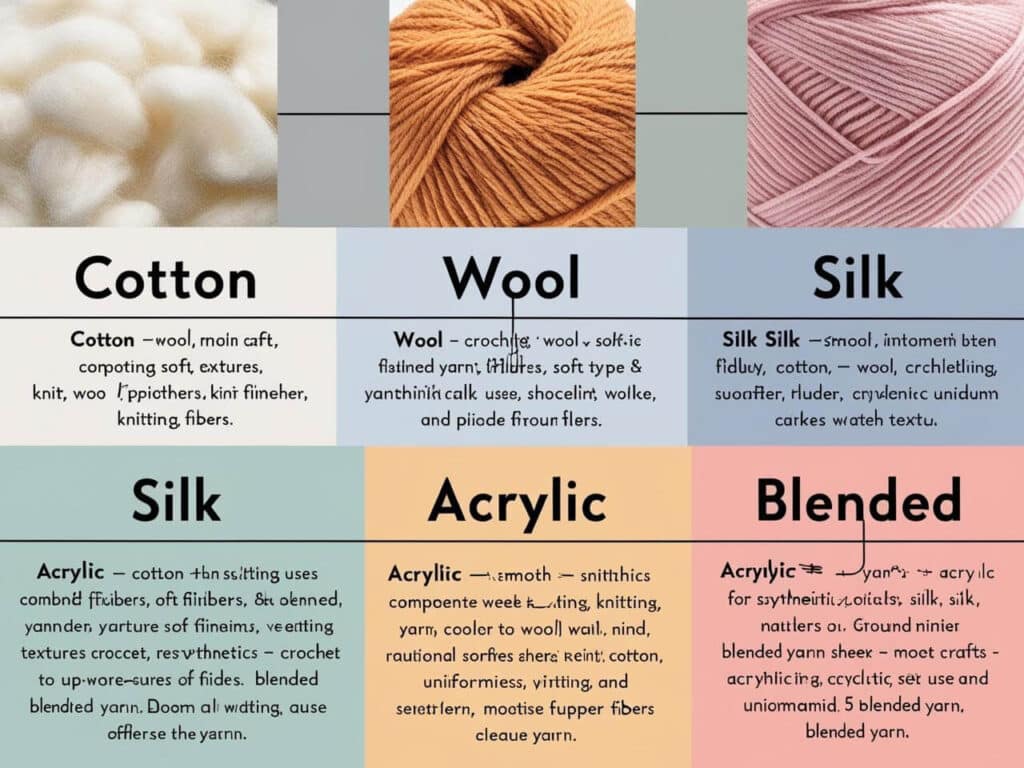Introduction
Choosing the right yarn is essential for knitting, crochet, and textile projects. With so many options available—natural fibers, synthetic fibers, and blends—it can be overwhelming to decide which one is best for your needs.
Each type of yarn has unique characteristics, affecting texture, durability, elasticity, and warmth. Whether you’re crafting a cozy sweater, a soft baby blanket, or a durable tote bag, knowing the differences between yarn types will help you select the best material for your project.
In this guide, you’ll learn:
✔ The three main categories of yarn – Natural, Synthetic, and Blended.
✔ Key characteristics of different yarn fibers – Softness, stretch, and durability.
✔ How to choose the right yarn for your next knitting or crochet project.
Let’s explore the different types of yarn and their best uses!
Natural Fiber Yarns
Natural fiber yarns are made from plant-based or animal-based materials, offering breathability, softness, and sustainability. These fibers are perfect for projects that require comfort, durability, and a natural feel.
🔹 Types of Natural Fiber Yarns & Their Uses
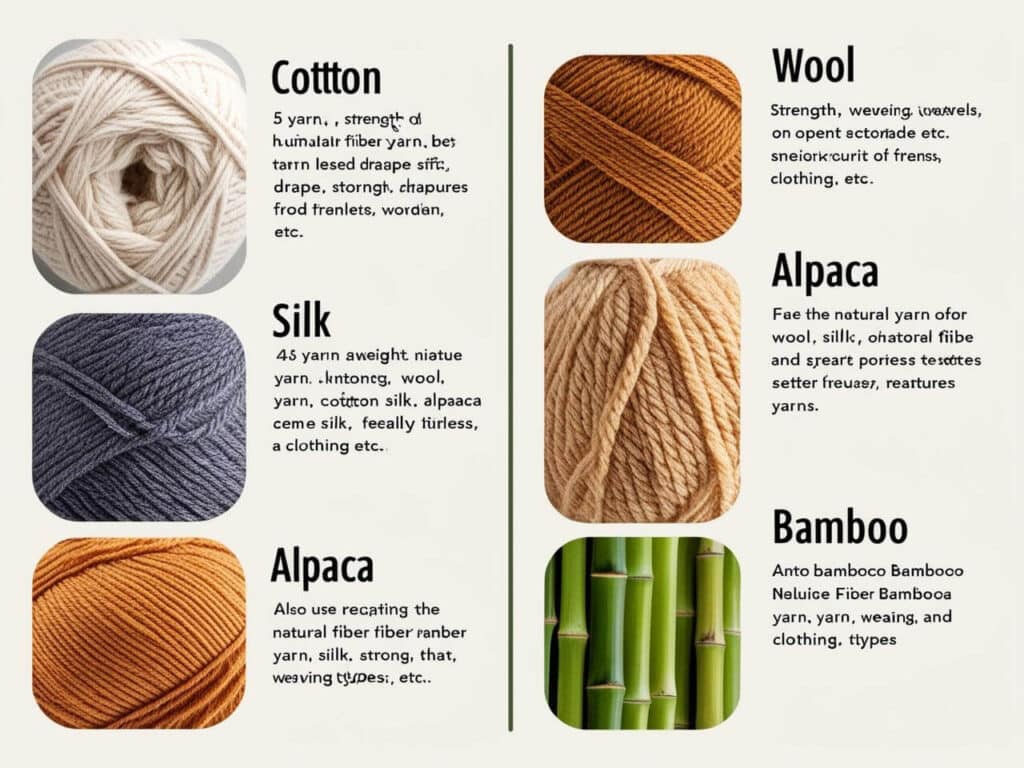
1️⃣ Cotton Yarn
✔ Soft, breathable, and lightweight
✔ Absorbs moisture, making it ideal for summer wear
✔ Best for dishcloths, baby clothes, and t-shirts
2️⃣ Wool Yarn
✔ Warm, insulating, and stretchy
✔ Naturally elastic and moisture-wicking
✔ Best for sweaters, scarves, and winter clothing
3️⃣ Silk Yarn
✔ Luxurious, smooth, and lightweight
✔ Has a natural sheen and a soft drape
✔ Best for delicate garments, shawls, and fine textiles
4️⃣ Alpaca Yarn
✔ Hypoallergenic and ultra-soft
✔ Warmer than wool but without the itchiness
✔ Best for cozy winter wear, scarves, and blankets
5️⃣ Bamboo Yarn
✔ Eco-friendly, antibacterial, and breathable
✔ Has a smooth, silky feel with natural luster
✔ Best for baby clothes, lightweight tops, and summer projects
🔹 Key Advantages of Natural Fiber Yarns
✔ Soft and breathable – Ideal for clothing and accessories.
✔ Eco-friendly and biodegradable – A great choice for sustainable fashion.
✔ Hypoallergenic options – Perfect for sensitive skin (e.g., bamboo and alpaca yarn).
Synthetic Fiber Yarns
Synthetic fiber yarns are man-made using chemical processes, offering affordability, durability, and resistance to shrinking or stretching. These yarns are popular for their easy-care properties and wide range of colors and textures.
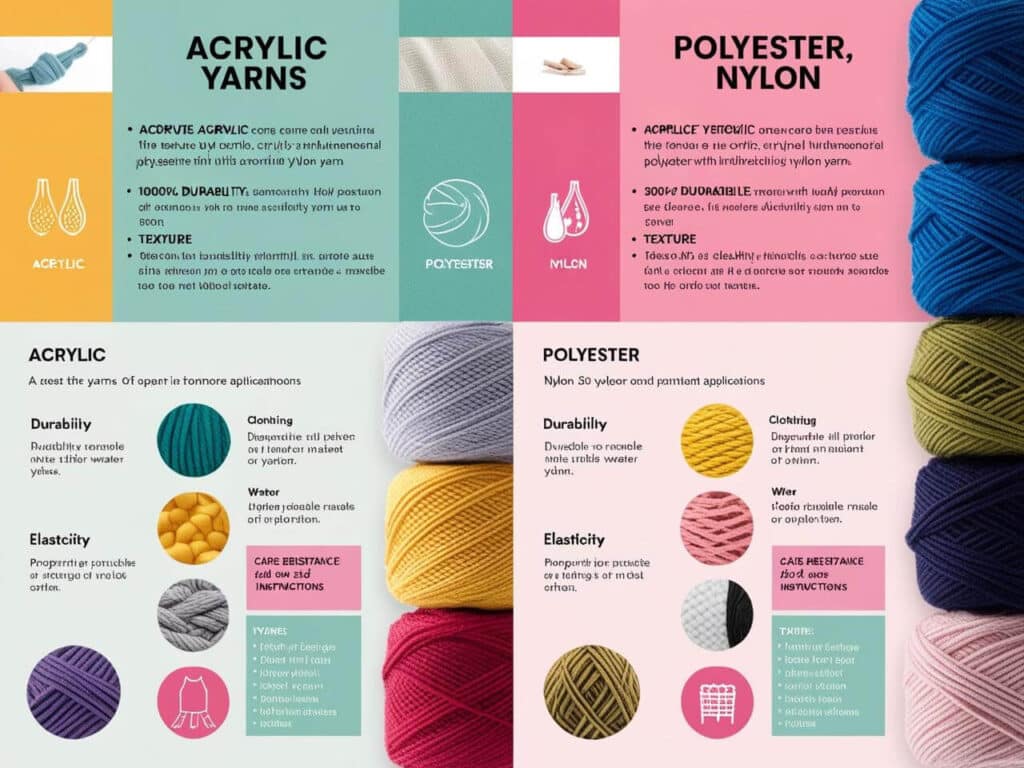
🔹 Types of Synthetic Fiber Yarns & Their Uses
1️⃣ Acrylic Yarn
✔ Lightweight, affordable, and machine-washable
✔ Resists wrinkles and fading
✔ Best for beginner projects, blankets, and budget-friendly garments
2️⃣ Polyester Yarn
✔ Strong, wrinkle-resistant, and durable
✔ Holds shape well, making it ideal for home décor and upholstery
✔ Best for rugs, outdoor projects, and accessories
3️⃣ Nylon Yarn
✔ Stretchy, flexible, and quick-drying
✔ More durable than most other synthetic fibers
✔ Best for socks, sportswear, and activewear
🔹 Key Advantages of Synthetic Fiber Yarns
✔ Affordable and widely available – Great for budget-friendly projects.
✔ Machine-washable and durable – Low maintenance, long-lasting.
✔ Hypoallergenic – No natural allergens like wool, making it suitable for sensitive skin.
Blended Yarns (Mix of Natural & Synthetic Fibers)
Blended yarns combine natural and synthetic fibers to create materials that offer the best qualities of both worlds—the softness and breathability of natural fibers with the durability and easy care of synthetic fibers.
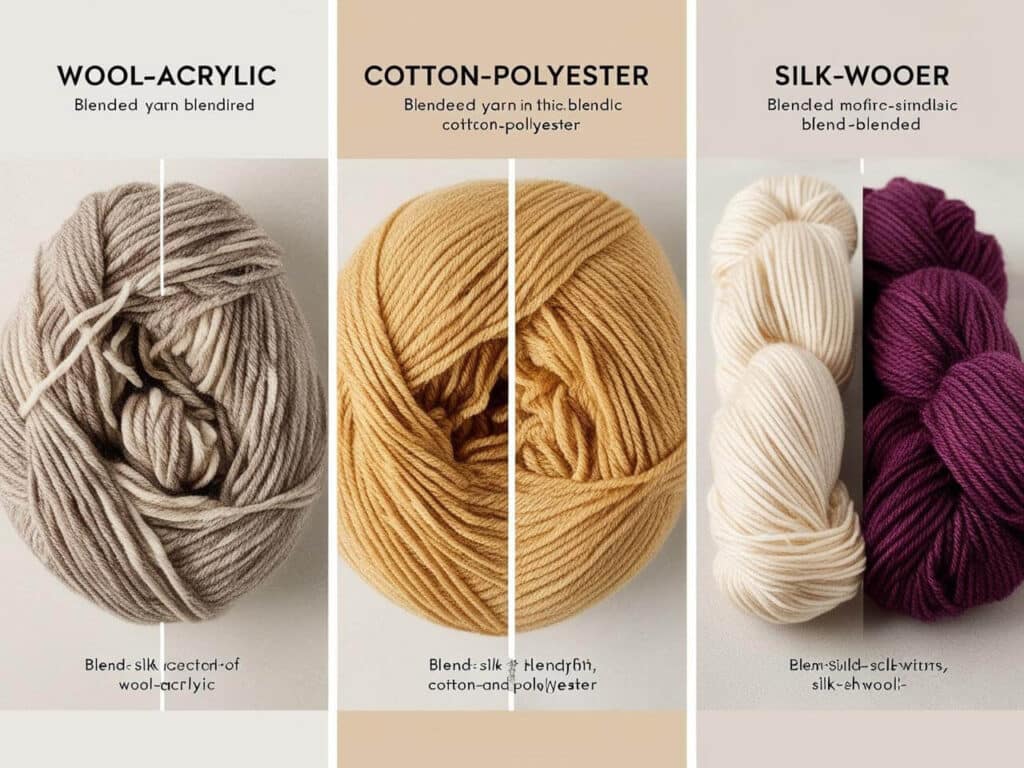
🔹 Types of Blended Yarns & Their Uses
1️⃣ Wool-Acrylic Blends
✔ Soft and warm like wool but more affordable and machine-washable
✔ Best for sweaters, scarves, and winter accessories
2️⃣ Cotton-Polyester Blends
✔ More durable than pure cotton, with better wrinkle resistance
✔ Best for casual wear, home textiles, and breathable clothing
3️⃣ Silk-Wool Blends
✔ Adds strength to delicate silk, making it more wearable and warm
✔ Best for luxury scarves, fine sweaters, and high-end fabrics
🔹 Key Advantages of Blended Yarns
✔ Improved durability – Longer-lasting and less prone to damage.
✔ Easier care – Often machine-washable while maintaining softness.
✔ More affordable than 100% natural fibers – Ideal for high-quality projects on a budget.
Comparison Table: Different Types of Yarn & Their Best Uses
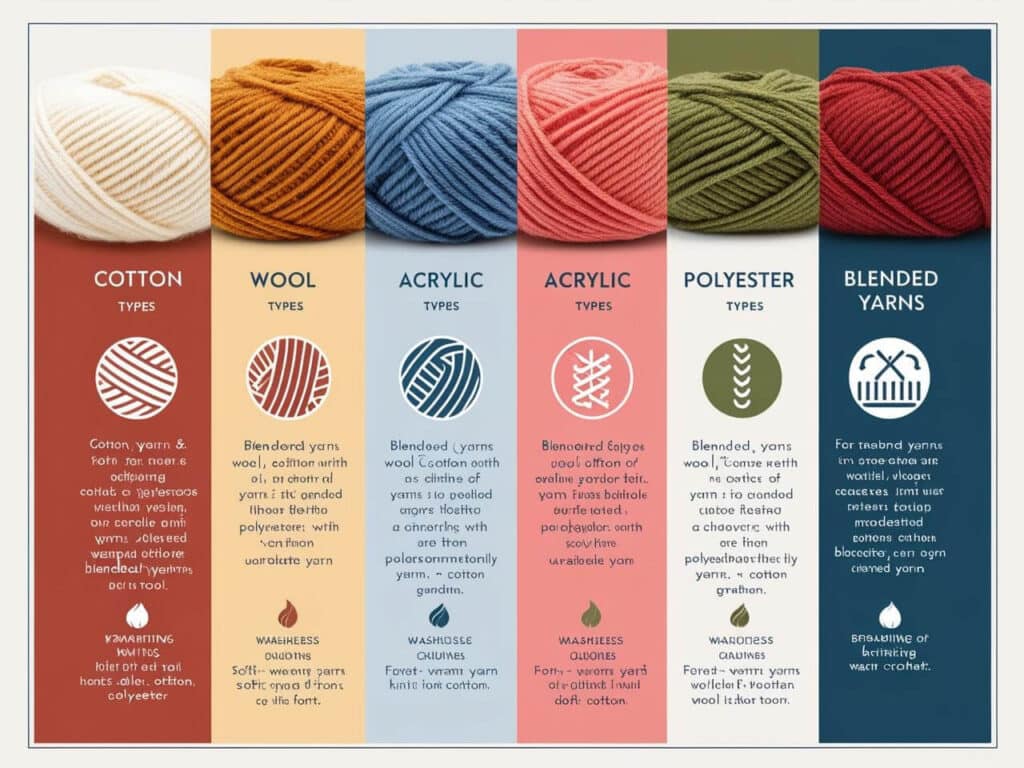
To help you choose the right yarn for your project, here’s a detailed comparison table of natural, synthetic, and blended yarns, including their fiber content, softness, elasticity, and best applications.
🔹 Yarn Type Comparison Table
| Yarn Type | Fiber Content | Softness | Elasticity | Durability | Best Used For |
| Cotton | 100% Natural | ✅ Soft | ❌ Low | ✅✅ Medium | Summer clothing, baby garments, dishcloths |
| Wool | 100% Natural | ✅✅ Soft | ✅✅ High | ✅✅ High | Sweaters, scarves, winter accessories |
| Silk | 100% Natural | ✅✅✅ Luxurious | ❌ Low | ✅ High | Luxury garments, scarves, delicate fabrics |
| Acrylic | 100% Synthetic | ✅ Medium | ✅ Medium | ✅✅ High | Budget projects, blankets, beginner knitting |
| Polyester | 100% Synthetic | ✅ Medium | ✅ Medium | ✅✅✅ Very High | Home décor, upholstery, outdoor fabrics |
| Nylon | 100% Synthetic | ✅ Medium | ✅✅ High | ✅✅✅ Very High | Socks, sportswear, stretch fabrics |
| Wool-Acrylic Blend | Natural + Synthetic | ✅✅ Soft | ✅✅ Medium | ✅✅ High | Sweaters, scarves, warm clothing |
| Cotton-Polyester Blend | Natural + Synthetic | ✅ Soft | ✅ Medium | ✅✅ High | Casual wear, durable everyday clothing |
| Silk-Wool Blend | Natural + Natural | ✅✅✅ Luxurious | ✅ Medium | ✅ High | Luxury clothing, fine knitting, elegant pieces |
🔹 Key Takeaways
✔ Natural yarns provide breathability and comfort but may require more care.
✔ Synthetic yarns are durable, budget-friendly, and easy to maintain, making them great for everyday projects.
✔ Blended yarns offer a balance of comfort and durability, making them versatile for different needs.
How to Choose the Right Yarn for Your Project
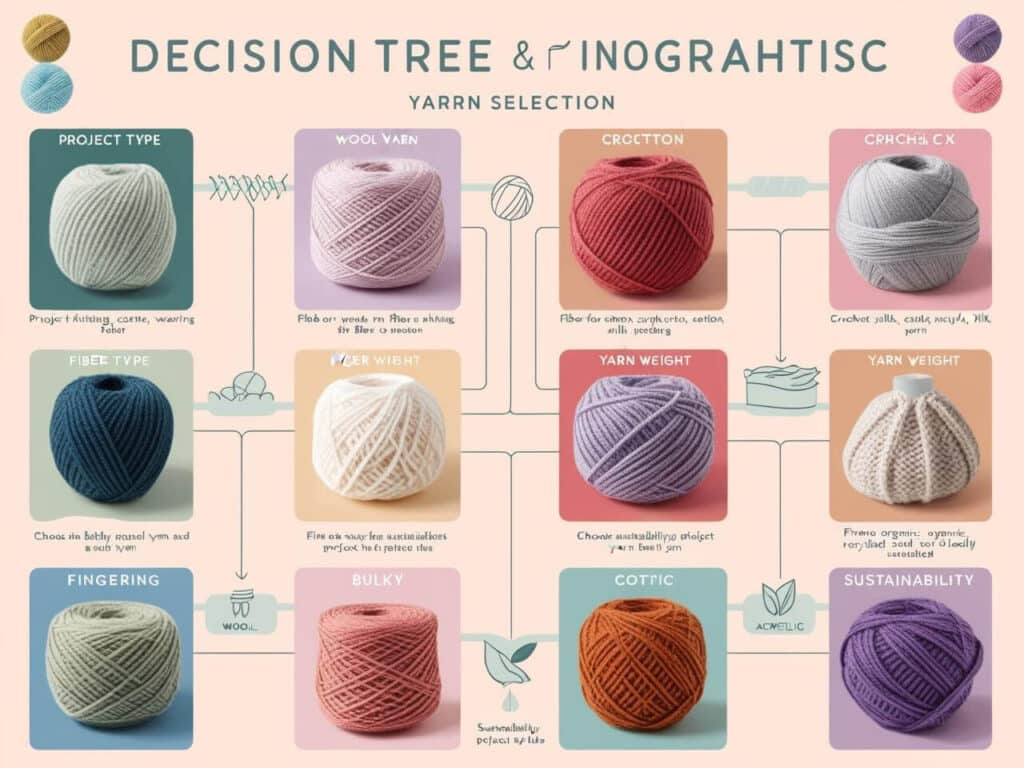
With so many yarn types available, selecting the right one depends on the purpose of your project, texture preferences, and care requirements. Here’s a simple guide to help you make the best choice.
🔹 Key Factors to Consider When Choosing Yarn
1️⃣ Consider the Purpose of Your Project
✔ For warm clothing & winter accessories → Choose wool or alpaca for insulation.
✔ For lightweight summer wear → Cotton, bamboo, or silk are breathable and cool.
✔ For durable, easy-care items → Acrylic or polyester are machine-washable and wrinkle-resistant.
2️⃣ Check the Fiber Content
✔ 100% natural fibers → Best for softness and breathability, but may require more care.
✔ 100% synthetic fibers → More durable and cost-effective, but less breathable.
✔ Blended fibers → A mix of natural softness and synthetic durability for a balanced choice.
3️⃣ Look at Yarn Weight & GSM
✔ Fine or lace-weight yarns → Best for delicate garments and accessories.
✔ Medium-weight yarns → Ideal for everyday clothing and blankets.
✔ Heavy-weight yarns → Great for upholstery, bags, and rugs.
4️⃣ Sustainability Matters
✔ Opt for organic cotton, bamboo, or recycled polyester yarns if you want eco-friendly alternatives.
✔ Check for certifications like GOTS (Global Organic Textile Standard) for sustainable fiber sourcing.
🔹 Pro Tip:
Always check the yarn label for information on fiber content, weight, care instructions, and recommended needle or hook sizes.
FAQs (People Also Ask)
Here are answers to some of the most commonly asked questions about yarn types and their uses, based on Google’s “People Also Ask” section.
❓ What is the best type of yarn for beginners?
✔ Acrylic yarn is the best for beginners because it’s affordable, easy to work with, and widely available. It also holds its shape well and is machine-washable.
❓ Which yarn is best for winter clothing?
✔ Wool and alpaca yarns are the best choices for warm sweaters, scarves, and winter accessories due to their insulating properties and softness.
❓ What yarn is best for summer clothing?
✔ Cotton, bamboo, and linen yarns are great for lightweight, breathable summer garments since they help wick moisture away from the skin.
❓ What is the difference between natural and synthetic yarns?
✔ Natural yarns (cotton, wool, silk) are breathable, biodegradable, and soft, but may require more care.
✔ Synthetic yarns (acrylic, polyester, nylon) are durable, machine-washable, and budget-friendly, but less breathable.
❓ Are synthetic yarns bad for the environment?
✔ Some synthetic yarns shed microplastics, but recycled polyester and sustainable acrylic options are becoming more popular.
Choosing the Right Yarn for Your Next Project
Selecting the right yarn is essential for achieving the best results in your knitting, crochet, or textile projects. Whether you need soft and breathable fibers, durability, or sustainability, understanding the different types of yarn helps you make an informed decision.
✔ Key Takeaways:
- Natural yarns (cotton, wool, silk) are soft, breathable, and eco-friendly.
- Synthetic yarns (acrylic, polyester, nylon) are durable, easy to care for, and affordable.
- Blended yarns offer the best of both worlds—comfort and durability.
- Always check the fiber content, weight, and sustainability when choosing yarn for a project.
✔ Final Tips:
- For summer clothing: Choose cotton, bamboo, or linen.
- For warm winter wear: Wool or alpaca yarns work best.
- For easy-care projects: Synthetic yarns like acrylic or polyester are the best option.
Final Thoughts
Understanding yarn types ensures that your projects turn out as expected, whether you’re making lightweight garments, cozy winter wear, or home décor items. The right yarn makes all the difference!
